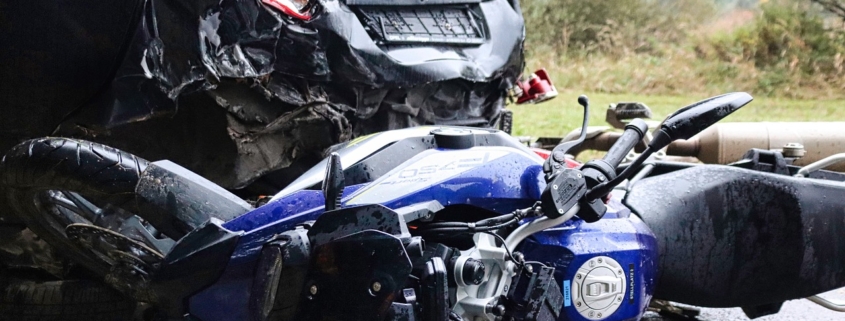How to Avoid Blind Spot Motorcycle Accidents
Motorcycles offer a fun and uninhibited way to get around, but they do come with risks that drivers of passenger vehicles never have to think about. One of the most prevalent dangers facing motorcyclists on the open road is the chance of being hurt in a blind spot accident. These accidents are sadly very common—a driver does not see a motorcyclist in their blind spot, and they hit them when they merge or turn.
If you or someone you love has been injured in a motorcycle accident, you could be entitled to compensation. Find out now by calling Turner, Onderdonk, Kimbrough & Howell at our Chatom office at 251-336-3411 or our Bay Minette office at 251-336-3697.
Understanding Blind Spots and Why Motorcyclists Are at Risk
Blind spots are an unavoidable risk in vehicles of all shapes and sizes. They are present on both the left and right sides of a car. On larger vehicles like tractor-trailers, they are also found in front of and behind the vehicle. A driver is supposed to turn and look over their shoulder before merging or turning so they can change course if there is someone in their blind spot. If drivers are supposed to be checking their blind spots before merging, why is this type of motorcycle accident so common?
To start, motorcycles are simply harder to see than larger passenger vehicles. While a driver might register that a car is in their blind spot, a motorcycle might be small enough to overlook. Additionally, motorcycles are faster and easier to maneuver in tight spaces than cars. A driver that checks their blind spot, waits for a second, and then merges could hit a motorcycle that entered their blind spot after they checked.
Of course, there is another explanation: some drivers just aren’t consistent with their blind spot checks. They may throw a halfhearted glance over their shoulder without actually looking for other drivers or riders. When this happens, they are at great risk of causing catastrophic or fatal injuries to motorcyclists.
How Motorcyclists Can Ride Defensively
Much of this falls on drivers. Though they are supposed to be especially cautious around motorcyclists, many are not. However, there are steps motorcyclists can take to protect themselves from blind spot accidents. They can:
- Position themselves carefully. Motorcyclists should have a general sense of where cars’ blind spots are and actively avoid lingering in those blind spots. By speeding up or slowing down, they make themselves more visible and decrease the risk of a blind spot collision.
- Use reflective gear. Reflective gear also makes motorcyclists more visible, increasing the likelihood they’ll be spotted by a merging driver.
- Choose their lane position carefully. Motorcyclists have an entire lane they can choose to use. Riding too close to the edge of the lane may make you much harder to see. Sticking closer to the center line is generally a safer choice when avoiding blind spot accidents.
- Avoid fast maneuvers. Remember, fast lane changes may cause a driver to change lanes before seeing you. Drive predictably and follow traffic rules.
Best Practices for Drivers
Driving a car is a significant responsibility. You are in charge of a multi-ton vehicle that has the capacity to cause fatal injuries. With a few safety tips, you can exercise extra caution around motorcyclists and help them feel safer on the road.
- Check blind spots thoroughly. It’s easy to get into the habit of doing a quick blind spot check that doesn’t actually give you the information you need. Hold yourself to a higher standard and focus on a thorough blind spot check before each lane merge.
- Position your mirrors before each drive. Careful positioning of your mirrors can shrink the size of your blind spot and help you avoid collisions.
- Do not drive while distracted. Distracted driving makes it even easier to miss a motorcycle in your blind spot. Keep your eyes and mind on the road.
- Leave extra space for motorcyclists. When a motorcyclist is in your midst, drop back or change lanes to give them extra space. Remember that they are at far greater risk of injury than you.
- Use your turn signal. This one is simple. Using your turn signal before merging gives motorcyclists the chance to switch lanes or honk to prevent a crash.
Choose Turner, Onderdonk, Kimbrough & Howell for Help with Your Motorcycle Accident Claim
After a motorcycle crash, it’s crucial to discuss your legal options with a personal injury lawyer. Our team is here to help. Set up a consultation now by calling our Chatom office at 251-336-3411, calling our Bay Minette office at 251-336-3697, or contacting us online.




Leave a Reply
Want to join the discussion?Feel free to contribute!